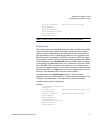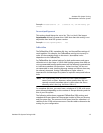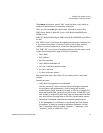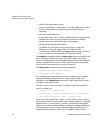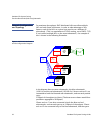StorNext File System Tuning
The Metadata Controller System
StorNext File System Tuning Guide 17
The cvdbset utility has a special “Perf” trace flag that is very useful to
analyze I/O performance. For example:
cvdbset perf
Then, you can use cvdb -g to collect trace information such as this:
PERF: Device Write 41 MB/s IOs 2 exts 1 offs 0x0 len 0x400000 mics
95589 ino 0x5
PERF: VFS Write EofDmaAlgn 41 MB/s offs 0x0 len 0x400000 mics 95618
ino 0x5
The “PERF: Device” trace shows throughput measured for the device I/O.
It also shows the number of I/Os into which it was broken, and the
number of extents (sequence of consecutive filesystem blocks).
The “PERF: VFS” trace shows throughput measured for the read or write
system call and significant aspects of the I/O, including:
•Dma: DMA
• Buf: Buffered
• Eof: File extended
• Algn: Well-formed DMA I/O
• Shr: File is shared by another client
• Rt: File is real time
• Zr: Hole in file was zeroed
Both traces also report file offset, I/O size, latency (mics), and inode
number.
Sample use cases:
• Verify that I/O properties are as expected.
You can use the VFS trace to ensure that the displayed properties
are consistent with expectations, such as being well formed;
buffered versus DMA; shared/non-shared; or I/O size. If a small I/O is
being performed DMA, performance will be poor. If DMA I/O is not
well formed, it requires an extra data copy and may even be broken
into small chunks. Zeroing holes in files has a performance impact.
• Determine if metadata operations are impacting performance.
If VFS throughput is inconsistent or significantly less than Device
throughput, it might be caused by metadata operations. In that
case, it would be useful to display “fsmtoken,” “fsmvnops,” and
“fsmdmig” traces in addition to “perf.”





